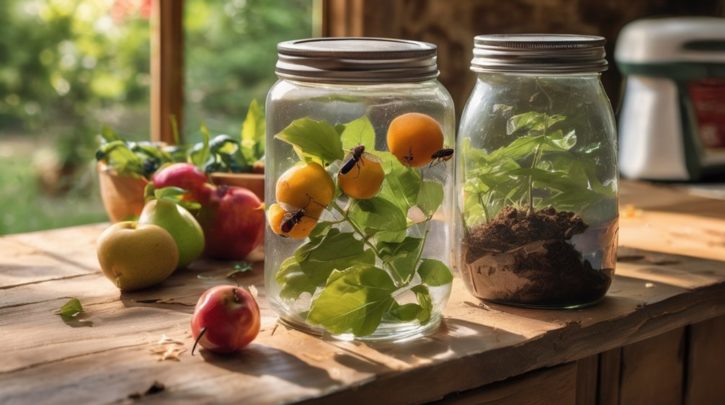To effectively control fruit flies, choose traps suited to your environment. In kitchens, use small enclosed traps with replaceable bait or disposable sticky types for easy cleanup. For gardens, select durable, weather-resistant designs with strong scents and wide attraction fields, like hanging or funnel traps. Compost bins benefit from sealed, baited liquid traps or sticky funnels near vents to limit odors. DIY options include containers with vinegar and soap covered by plastic wrap with holes. Exploring these options helps you identify the best fit for your needs.
How to Choose the Right Fruit Fly Trap for Your Needs
When selecting a fruit fly trap, you need to take into account several key factors to confirm it meets your specific requirements.
First, consider where you’ll use the trap—different environments, like kitchens or outdoor spaces, demand distinct designs.
Next, evaluate the trap’s capacity and how often you’re willing to maintain it.
Look for traps that use safe, non-toxic attractants if you want freedom from harmful chemicals.
Additionally, choose a model that’s easy to set up and clean to save time.
Top Fruit Fly Traps for Kitchen Use
Although fruit fly traps come in various designs, those intended for kitchen use prioritize compactness and ease of cleaning. You’ll want traps that fit discreetly on countertops or inside cabinets without clutter.
Look for models that are simple to empty and sanitize to maintain hygiene. Consider these top options for effective kitchen use:
- Small, enclosed traps with replaceable bait
- Disposable sticky traps for quick cleanup
- Reusable plastic traps with funnel entrances
- Electric traps with UV light attractants
- Natural traps using fruit and vinegar mixtures
Choosing the right trap helps you maintain a fly-free kitchen efficiently.
Effective Fruit Fly Traps for Garden Areas
Since garden environments expose traps to weather and larger spaces, you’ll need fruit fly traps designed for durability and broader coverage.
Look for traps made from weather-resistant materials like sturdy plastics or metals that can withstand rain and wind.
Consider designs that attract fruit flies over a wide area, such as traps with strong scents or large openings.
Hanging traps or those placed near plants will help intercept flies before they spread.
Regularly check and replace bait to maintain effectiveness.
Best Traps for Managing Fruit Flies in Compost Bins
Because compost bins provide an ideal environment for fruit flies to breed, controlling them requires specialized traps designed for confined, moist spaces.
You’ll want traps that effectively attract and capture flies without disturbing the compost process. Consider these options:
- Enclosed liquid traps with non-toxic attractants
- Sticky traps placed near bin vents
- Funnel traps that guide flies inside but prevent escape
- Baited traps using yeast or vinegar solutions
- Sealed container traps that limit odors and access
These traps help you manage fruit fly populations discreetly, maintaining your compost’s health while keeping your space fly-free.
DIY Fruit Fly Trap Solutions You Can Make at Home
How can you create effective fruit fly traps using items already available at home?
Start by filling a small container with apple cider vinegar or a piece of overripe fruit. Cover the container with plastic wrap and secure it with a rubber band. Poke small holes in the wrap to allow flies to enter but prevent escape.
Alternatively, mix dish soap with vinegar to break surface tension, trapping the flies.
These simple traps use common household materials and require minimal setup. By regularly replacing the bait and cleaning the traps, you maintain their effectiveness and reduce fruit fly populations efficiently.
Frequently Asked Questions
Can Fruit Fly Traps Harm Beneficial Insects?
Yes, fruit fly traps can sometimes catch beneficial insects, but you can minimize this by choosing traps designed to target fruit flies specifically and placing them carefully away from plants where helpful bugs thrive.
How Often Should I Replace Fruit Fly Traps?
You should replace fruit fly traps every one to two weeks or when they’re full. This keeps them effective, preventing overcrowding and ensuring you stay in control without letting those pesky flies take over your space.
Are Fruit Fly Traps Safe to Use Around Pets?
Yes, you can safely use fruit fly traps around pets, but keep traps out of their reach to avoid accidental contact. Choose non-toxic, pet-friendly options and monitor the area regularly to keep your furry friends safe and happy.
Can Fruit Fly Traps Be Used Indoors and Outdoors Simultaneously?
Yes, you can use fruit fly traps indoors and outdoors at the same time. Just place them where flies gather most, and you’ll reclaim your space effortlessly, enjoying freedom from those pesky pests everywhere you want.
Do Fruit Fly Traps Attract Other Pests Besides Fruit Flies?
Yes, fruit fly traps can attract other small flying insects like gnats or mosquitoes. But don’t worry—you can customize your trap’s bait to target fruit flies specifically, keeping unwanted pests away while you take control.
Christina Pulluck helped bring Nebula Electronics from a a science and tech decision forum to a full-fledged news site by creating a new design and branding. She continues to assist in keeping the site responsive and well organized for the readers. As a contributor to Nebula Electronics, Christina mainly covers mobile news and gadgets.

